The text starts with...
The text starts with a poem about our home town. We can talk with our child about our town’s characteristics, and switch the last sentence with a one that relates to our town.
Who are our neighbors...
Who are our neighbors? We can talk with our child about the nearby villages and towns that he visits sometimes and see what connections he makes to each one.
The illustrations highlight...
The illustrations highlight the most prominent spots in each town and village. We can help our child to identify these spots through the illustrations such as the Dome of Bahai or the light house of Akko.
Does the book...
Does the book motivate us to go on a journey to different places? It would be nice to go and take family pictures and then hang them on the string in the last two pages of this book. We can also collect all the pictures in a small memory box.
Let’s have a conversation...
About the landmarks of Baghdad and the market: The events of the story took place in Iraq, and important landmarks and places were mentioned to us, such as: Baghdad; the Copper market; Bab al-Sham; House of Wisdom Library. We can look for information and pictures of these places, and we can talk about them with our children. We can talk about the most important landmarks and places in our town and ask our children: Which of them are the most beloved to them? And why?
About the feelings, desires, and thoughts of the characters: We can trace the drawings and talk with our child about various events. We can ask them, for example: What did Aladdin feel when he entered the Cave of Treasures? Why did Hanish ask him for the old copper lamp instead of the treasures, and how did Aladdin feel about that? What did he do, and what was Hanish’s reaction and feeling?
About solving problems and getting out of trouble: Aladdin faced several predicaments. We can follow the drawings with our child and we can ask them: How did Aladdin get out of the cave? How did he feel in prison, and how did he get out of it? How did Princess Asmahan save the lamp from Hanish’s hands? We can also ask our child: Did they ever get into trouble? How did they feel? How did they get out of it?
About good and evil: Princess Asmahan released the genie and asked him to travel the world and help people. We can talk to our child about good and evil; We could ask them the follwoing: How can we describe the behaviour of the princess? What does it mean to do good? What is the meaning of evil? How did that appear in the story? Have they done a good deed, or have they thought of magically turning something from bad to good? We can suggest some good deeds and help our child to do them.
About the qualities and uniqueness of the characters: We can talk with our children about the characteristics of Princess Asmahan and compare them with the qualities of the minister, of Hanish and Aladdin and we can compare them with her behaviours in the story. We can also talk with them about their own qualities and how they appear in their behaviour. We can say, for example, that Princess Asmahan is brave and hastened to take the lamp when it fell. What are the characteristics that distinguish our children, and how do they stand out in their behaviour?
Let's imagine...
“Journey to the land of dreams.” We can encourage our child to imagine a genie that will carry them to dreamland. What do they love about this place?
Let’s enrich our language...
The story is rich in beautiful and new linguistic vocabulary; we can explain them to our children while reading and we can talk about them afterwards as well.
Let's create...
We draw our child’s attention to the rhyming words in the text. We can help them compose his own chant using rhyme.
Let’s explore...
Several films have been released about the story, the last of which was Disney’s “Aladdin” movie. We can search for it on the web, and we can spend quality time with our family watching it. It is interesting to then compare the movie and the book.
If your friend...
If your friend is good as honey, don’t lick him all We can go over the situation without mentioning the idiom, and have a small conversation with our children regarding the child’s desires in the story: are they logical? Can the mother give the child everything he/she wants? We can read the idiom and look at the drawing that describes it: who is the honey in the drawing? What does the drawing tell the child?
The camel limped...
The camel limped because of his lips. Children sometimes try to make any excuse to avoid going to school. It is important to listen carefully to what the child says directly, and try to understand if there is an indirect call of distress because of something the child is going through. We can go over the situation, without reading the idiom, and have a conversation concerning the reasons why the child in the book may not want to go to kindergarten. We can take a look on the camel drawing: does his swallowed lip forbid him to walk?
The pot found...
The pot found its cover. We can talk with our children about the 2 friends in the story: do they love the same games? We can take a look at the drawing and have a conversation about the similarity between the pot and its cover to the two friends in the story. We can have a conversation about our friends who can be a “cover to our pot”: what do we like to do with them?
A hair grew on...
A hair grew on my tongue We can check our tongue: can hair grow on it? Can it grow one day? We can read the situation that talks about the mother who asked her child, several times, to clean up his room: What happened to her tongue as a result of repeating the same sentence? We can imagine different things that might happen to her tongue. We can think together: What can the child and his mother do, so “hair won’t grow on her tongue”?
Tanbouri's shoes are...
Tanbouri’s shoes are old and full of patches and holes. What is the reason?
We can imagine...
We can imagine together with our children other ways for Tanbouri to get rid of his shoes.
We have an emotional...
We have an emotional relation to some of the old things which we keep. We can talk to our children about these emotional relations. Maybe you would like to draw or to take a photo of these things to keep as a memory with your children.
Tanbouri's neighbors...
Tanbouri’s neighbors found the shoes and brought them back to him. Try to think with your children about things that we found and brought back to their owners. How did the person feel? How did we feel?
Tanbouri's shoes became...
Tanbouri’s shoes became so famous, the Sultan ordered them put in a glass box and told his story. We can have a talk with our children about things that we exhibit in glass boxes at home or at the museum. What characterize these objects? Maybe we can go to museum to see the difference.
We can play...
We can play “find the shoe”. We can hide a shoe and ask our children to look for it.
What we can do...
What we can do with an old shoe? we can plant flowers in it, or maybe we renew it.
We can look...
We can look together at the illustrations at the beginning of the book. What do the illustrations say about each character?
We can stop...
We can stop at every funny situation in each tale: why did No’aman, Sabbour and the people in the market laugh?
The last illustration...
The last illustration in the book answers Jouha’s question to No’aman: “What are we going to do now!” Encourage our child to think of alternative funny answers: Maybe he would like to draw his answer.
We are sure that...
We are sure that some of your family members know some of Jouha tales. Why not write down or draw these tales on the blank pages at the back of the book?
 Oh Flying Bird
Oh Flying Bird 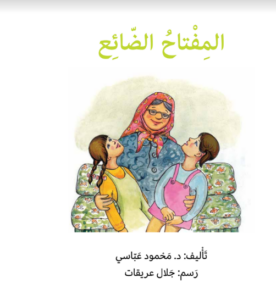 The Lost Key
The Lost Key 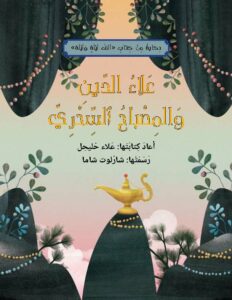 Aladin and the Magic Lamp
Aladin and the Magic Lamp 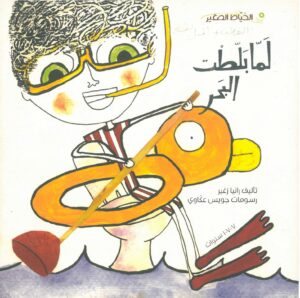 When I Paved the Sea
When I Paved the Sea 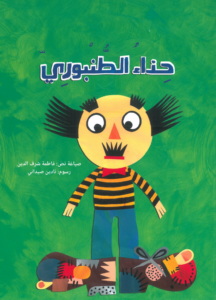 Tanbouri Shoes
Tanbouri Shoes 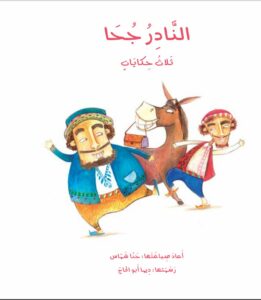 Tales of Jouha
Tales of Jouha 
